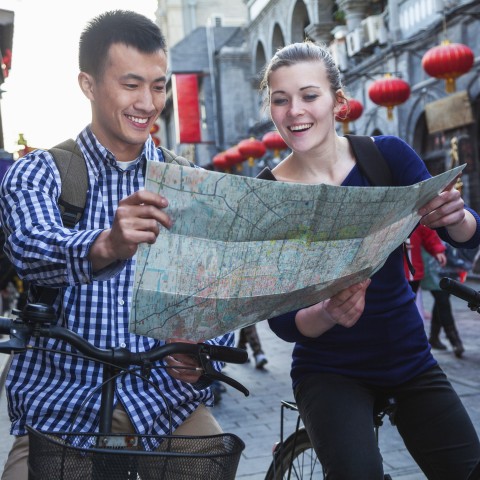One of the most common answers language learners give when we’re asked why we chose to learn that language is because we like the country or countries where it’s spoken. Therefore, it’s not a surprise that if you’re learning Spanish, you might like to visit Spain. So why not learn Spanish travel words and phrases?
Whether you choose to travel to Spain for a short holiday or for a longer time, here you’ll learn all the vocabulary you need to find your way in Madrid, Barcelona, Seville, or any other city you want to visit. You probably already know that Spanish people aren’t that great at speaking English, especially in small towns, so if you want to avoid misunderstandings, this is the way to go.
Our purpose today is to teach you some common Spanish travel phrases that will help you be understood if you need help while you’re traveling in Spain—or if you want to order food, book a hotel room, get a cab, or take the bus. But even more importantly, we’re going to help you understand the answers you’ll receive!
Surely you don’t want to ask a local how to get to your hotel only to not understand the answer. That would make the whole process of learning the questions quite useless, wouldn’t it? Well, there’s no need to worry, because we’re making sure our guide of Spanish for travelers includes all of the Spanish phrases for travel you’ll need.
Without further ado, let’s delve into our list of useful Spanish words for tourists!
Table of Contents
- Ten Basic Expressions
- Nine Simple Conversation Phrases
- Nine Basic Spanish Phrases for Travel
- Seven Sentences You Might Need When Shopping
- Nine Sentences You Might Need in a Restaurant
- Nine Sentences to Ask for and Give Directions
- Six Expressions You Might Need in Case of an Emergency
- Five Flattery Phrases
- Ten Useful Phrases to Go through Language Problems
- How SpanishPod101.com Can Help You Learn Spanish
1. Ten Basic Expressions
Let’s start from the beginning. It’s practically impossible to have a proper conversation without using any of these basic expressions, so you’re going to need them. If you already know them, don’t worry; you can skip this section! And keep in mind that to hear these Spanish travel phrases with pronunciation, as well as more Spanish words and phrases, you can visit our vocabulary lists on our website.
1- Hola
As most of you might already know, Hola means “Hello.” It’s by far the most commonly used greeting in Spanish and can be used at any time of the day.
If you would like to learn more ways of greeting someone, you can check out our article How to Say Hello in Spanish.
2- Gracias
Once again, this is one of the most common Spanish words. It means “Thank you” and it’s obviously a basic word in many conversations. We would like our tourists to be polite, so we hope you use it a lot!
3- De nada
Now you know how to say “Thank you,” but do you know what to say after someone thanks you in Spanish? De nada literally means “Of nothing” and it translates to “You’re welcome.”
4- Sí
In our first list of basic expressions in Spanish, we can’t forget to include words like “Yes” and “No.” Again, you probably already knew that sí means “yes,” but here it is just in case!
5- No
This is clearly one of the easiest travel phrases in Spanish for most of you. No in Spanish means “no.”
6- Lo siento
Lo siento is one of the most common ways of saying “I’m sorry” in Spanish and you can use it the majority of the time when you wish to apologize to someone. But if you would like to know what the most appropriate expression is for different situations, feel free to read our article on How to Say “Sorry” in Spanish.
7- No hablo español
If you don’t feel comfortable enough speaking Spanish yet, it might be useful for you to be able to say “I don’t speak Spanish.” If you want to apologize for not speaking Spanish, remember that you can combine it with the previous expression on the list: Lo siento, no hablo español.
8- Me gusta
Whenever you want to express that you like something, you can say Me gusta. If you want to be specific and say what it is that you like, you can add a verb in its infinitive form, a noun, or a pronoun.
Example: Me gusta bailar.
Translation: “I like dancing.”
Example: Me gustan los helados.
Translation: “I like ice cream.”
9- No me gusta
If you don’t like something, all you need to do is add no just before me gusta.
Example: No me gusta correr.
Translation: “I don’t like running.”
10- Por supuesto
The last expression on this list might not be as important as the rest, but it’s still good to know. Por supuesto means “of course.”
2. Nine Simple Conversation Phrases
Besides the basic expressions we just saw, there are a few sentences you might need to know so that you can have a basic conversation when you meet someone for the first time. These are often included in some of the first lessons when you start learning a language, but they’re always good to review.
You might want to take a look at our Top 10 Sentence Patterns for Beginners in case you’re not too familiar with them yet.
1- ¿Cómo te llamas?
One of the first questions you might ask someone you just met is “What’s your name?” This is one of the key Spanish travel phrases you should know, especially when it comes to forming relationships while in Spain.
2- Me llamo Ana / Soy Ana.
Obviously, if you learn how to ask what someone’s name is, you also need to know how to reply! Two of the most common ways of saying “My name is…” are Me llamo… or Soy… followed by your name. The last one only means “I’m…” but just like in English, it’s still an option.
3- ¿Cuántos años tienes?
This is another common question: “How old are you?” Interestingly, when we talk about our age in Spanish, we use the verb tener, which means “to have.” This means that the literal translation to this question is “How many years do you have?”
4- Tengo 25 (veinticinco) años.
As mentioned above, the literal translation to this answer is “I have 25 years.” Of course, it translates to “I am 25 years old.”
If you’re not yet comfortable with numbers in Spanish, we have you covered: check out our Numbers in Spanish article.
5- ¿De dónde eres?
This question means, “Where are you from?” Because people are normally curious when they hear a foreign accent or language, it tends to be heard quite frequently when someone’s traveling.
6- Soy de Australia / Soy australiano/a.
There are two different ways of replying to the previous question, and they’re very similar to what you would say in English. Soy de Australia means, “I am from Australia,” and Soy australiano (or australiana) means “I’m Australian.”
To learn more nationalities in Spanish, take a look at our Spanish Vocabulary for Nationalities.
7- ¿Dónde vives?
And finally, here’s our last basic question. ¿Dónde vives? means “Where do you live?”
8- Vivo en Londres
As you might expect, this sentence is the answer to the previous question. Vivo en Londres means “I live in London.” We chose this city because its name is a bit different than it is in English.
Now you might be wondering if all cities have different names in Spanish. Well, luckily, this doesn’t always happen, but it does happen sometimes. Normally, when they’re not that easy to pronounce for Spanish speakers, the names will be changed. Here’s a list of Names of World Cities in Spanish that might help you.
9- ¿Me puedes sacar una foto?
This sentence isn’t as important as the rest, but it’s still really useful to know when you’re traveling. If you travel solo and your parents want to see how you’re doing on your travels, but you’re not a big fan of selfies, you’re going to have to ask someone to take a photo of you.
The way of asking “Could you take a photo of me?” in Spanish is ¿Me puedes sacar una foto?
Of course, if you’re traveling as a couple or even with a group, you might still want to ask a local to take a photo of you. You can ask this question in the plural by saying: ¿Nos puedes sacar una foto?
For a few more useful questions, take a look at our Top 15 Spanish Questions You Should Know for Conversations.
3. Nine Basic Spanish Phrases for Travel
Let’s get to more specific and useful Spanish travel phrases. Regardless of where you’re traveling, you’ll be taking cabs, trains, or buses. This is why we’ve listed a few sentences you might need if you take any of these means of transportation.
In each of these examples, we’ve marked in bold the most important part of the sentence. So, if you need to use any of these essential Spanish travel phrases for transportation, you’ll use the part in bold and change the rest of the sentence whenever you need to.
1- Three Sentences You Will Need When You Take a Cab
- ¿Dónde puedo coger un taxi?
Translation: “Where can I take a cab?” - Me puedes llevar a la calle San Juan, ¿por favor?
Translation: “Could you take me to Saint John’s Street, please?” - Al aeropuerto, por favor.
Translation: “To the airport, please.”
2- Three Sentences You Will Need When You Take a Train
- Dos billetes para ir a Pamplona, por favor.
Translation: “Two tickets to go to Pamplona, please.” - Un billete de ida y vuelta a Madrid, por favor.
Translation: “One round-trip ticket to Madrid, please.” - ¿En qué andén se coge el tren R5?
Translation: “On which platform can I take the R5 train?”
3- Three Sentences You Will Need When You Take a Bus
- ¿Me puedes avisar cuando lleguemos al Museo del Prado?
Translation: “Could you let me know when we arrive to the Museo del Prado?” - ¿Dónde me bajo para visitar la catedral?
Translation: “Where do I get off to visit the cathedral?” - ¿Qué autobús tengo que coger para ir a Valencia?
Translation: “What bus do I need to take to get to Valencia?”
4. Seven Sentences You Might Need When Shopping
No matter what kind of trip you’re on, you’ll need to buy something at some point. It could be food, clothes, medicine…who knows. We’ve put together a few sentences you might need in order to buy something in Spain. These may be more advanced Spanish phrases for travel, but you can definitely master these with enough practice!
1- ¿Cuánto cuesta?
When we’re shopping, we sometimes need to ask about the price of a product, more often than not due to misplaced price tags. This is why asking “How much does this cost?” is such an important question to know. Obviously, the answer to this question is even more important. Here’s an example of how a conversation might go:
Example:
A: Perdona, ¿cuánto cuesta esta chaqueta?
B: Cuesta 35 (treinta y cinco) euros.
Translation:
A: “Excuse me, how much does this jacket cost?”
B: “It costs 35 euros.”
In case you skipped the simple conversation section in this article, we’ll remind you once more that if you want to know more about numbers in Spanish, you can check out our Numbers in Spanish article.
2- ¿Qué me recomiendas?
This question means, “What’s your recommendation?” and you might need to use it when you’re not sure what to get.
For example, one thing we’re really proud of in Spain is our jamón. You might want to try it when you visit Spain, but when you come to our supermarkets or restaurants and see all the different kinds we have, you might be confused.
In our example, because we’re asking for a specific recommendation, we’ll add a noun—the thing we’re interested in—after qué. This is optional except when what you’re referring to isn’t that obvious.
Example:
A: Qué jamón me recomiendas?
B: Este es buenísimo y no es muy caro.
Translation:
A: “What ham do you recommend?”
B: “This one is really good and it’s not too expensive.”
3- Quiero cambiar dólares a euros.
When traveling, you might need to exchange your currency for the local one, which in this case is the Euro. Specifically, the translation of this sentence is, “I want to exchange dollars for euros.”
For more information on talking about money or currency in Spanish, you might find it useful to check this vocabulary list of Words Related to Trade.
4- ¿Cómo puedo conseguir un descuento?
You might not be able to use this one as often as the other sentences on this list, depending on where you are, but it’s still good to know how to ask the question, “How can I get a discount?”
5- ¿Tienes esta camisa en otro color?
In case you see a shirt you like, but you can’t stop thinking that it would look better in a darker color, you might want to know how to ask ¿Tienes esta camisa en otro color? which means “Do you have this shirt in a different color?”
Other similar questions you might need to ask include asking for a different size. Here’s an example:
Example:
A: Perdona, ¿tienes estos pantalones en una talla más grande?
B: Lo siento, solo tenemos esta talla o una más pequeña.
Translation:
A: “Excuse me, do you have these trousers in a bigger size?”
B: “I’m sorry, we only have this size or a smaller one.”
6- ¿Se puede pagar con tarjeta?
You’ll never have to ask “Can I pay by card?” in a big supermarket, but it might be helpful if you’re buying something in a small store, or in a local market.
7- ¿Dónde hay un cajero?
In case the answer to the previous question is “No” and you currently don’t have any cash on you, you’re going to need to ask where the nearest ATM is. The way to ask this is ¿Dónde hay un cajero?
If you think you might have trouble understanding the possible answers to this question, keep reading this article!
5. Nine Sentences You Might Need in a Restaurant
When it comes to Spanish travel and tourism vocabulary, we think that restaurant words and phrases just about top the list.
In this section, we’ve included a few sentences you’ll need in a restaurant. However, if we started listing all the vocabulary you would need to order food, we would be here all night long, so this is why we recommend our video All Food and Restaurant Phrases You Need. In this video, Rosa will explain everything you need to know about food in general, and also about Spanish food.
1- Mesa para dos, por favor.
Unless you’re at a fast-food restaurant, normally one of the first things you’ll have to tell the waiter is how many people will be eating, so that they can pick the right table for you. This situation can take place in a few different ways.
For example, the waiter might ask you as soon as you walk in how many people there will be. There are a few ways they can ask you this question, but the one thing we know for sure is that it will include the word cuántos, which means “how many.” He could ask ¿Cuántos son? which means “How many are you?” or ¿Mesa para cuántos? which means “Table for how many?” among others. If you’re asked this question, you can just say the number, or the magic sentence in the title.
There’s a second way this could happen: the waiter might count how many people he sees before asking that question. For example, if he counts four people, he might directly ask: ¿Mesa para cuatro?, which means, “Table for four?” If he gets the number right, you can just reply Sí. If he gets it wrong, you can correct him with the right number.
Finally, the third way this situation could go. You could be faster than the waiter and say Mesa para dos, por favor, which means “Table for two, please.” We previously said this is a magic sentence; let us explain why. If you’re still nervous whenever you need to speak Spanish and you didn’t understand what the waiter said to you, they’ll completely understand if you just say these words. Just like that, you’re in! Now let’s get you ready for what comes right after that.
2- ¿Cuál es el menú del día?
It’s common for Spanish restaurants to have a special menu for each day. Before deciding what you want to order, you can ask them ¿Cuál es el menú del día? which means “What’s the menu of the day?”
If you don’t like the special menu, don’t worry, because they’ll always have more options on the regular menu.
3- Por favor, ¿me tomas nota?
It’s quite likely that the waiter will approach you after you’ve been deciding what to get for a while. But in case you’re getting hungry and the waiter hasn’t asked what you would like to eat yet, when you see him you can ask him Por favor, ¿me tomas nota? which translates to “Can you write down my order, please?”
4- ¿Qué van a tomar?
Once the waiter has approached your table, you’ll be asked what you would like to order. It’s common for waiters to use the formal usted instead of tú, so the sentence we’ve suggested, ¿Qué van a tomar?, uses that form.
Another similar question the waiter might ask you is: ¿Ya han decidido qué van a tomar? which means “Have you decided what you’re going to have?”
Notice that both examples are in the plural. If you were eating by yourself in the restaurant, the waiter would ask ¿Qué va a tomar? instead.
5- Yo tomaré…
Of course, if you’re eating in a restaurant, you need to know how to tell your waiter what you would like to eat. Here’s an example of how to order your food in Spanish.
Example: Yo tomaré las costillas de cerdo con ensalada.
Translation: “I will have the pork ribs with salad.”
6- ¡Camarero/camarera!
If you need to call the waiter for any reason, unless you know his or her name, you’ll have to say “Waiter!” or “Waitress!” This is one of the many reasons why you should know how to say it in Spanish. If your server is a girl, you’ll have to say ¡camarera!, and if it’s a man, you’ll say ¡camarero! If you feel like that’s a bit too rude for you, you can also say Perdona, which means “Excuse me.” Here’s an example that we hope you won’t need:
Example: ¡Camarero! ¡Hay un pelo en mi sopa!
Translation: “Waiter! There’s a hair in my soup!”
7- ¿Algo más?
This question means, “Anything else?” and might be asked after you’ve ordered your food and the waiter wants to make sure that you’ve finished.
The answer to this question, if you have in fact finished ordering, could be No, eso es todo, which means “No, that is all.” If you still want to order something else, you can of course say Sí, followed by your next order.
8- Tengo alergia a…
For people with allergies, it’s important to be able to let the waiter know about it. The way to say, “I’m allergic to…” is Tengo alergia a…
Example: Tengo alergia a los cacahuetes.
Translation: “I’m allergic to peanuts.”
You might also want to ask if a specific dish contains an ingredient in particular.
Example: Perdona, ¿la crema de calabaza lleva lactosa?
Translation: “Excuse me, does the pumpkin soup contain lactose?”
To be even safer, you can check Spanish Materials and Resources from Food Allergy Research & Education for some help.
9- La cuenta, ¿por favor?
The last sentence on this list is what you might need to say last, before you leave. As you might have guessed, this is how to ask for the bill. This sentence means “The bill, please?” and even though you could ask using a full sentence instead, this is all you’ll need.
6. Nine Sentences to Ask for and Give Directions
We’re sure you knew this section would come. After all, learning directions are some of the most essential travel phrases in learning Spanish and we don’t want you to get lost when you visit our beautiful country. But if you do, we want to help you find your way.
Here are some sentences you might need if you’re lost or can’t find your destination. Because these sentences have quite simple meanings, we don’t think you’re going to need anything but their translations.
1- Estoy perdido.
Translation: “I’m lost.”
2- ¿Dónde está la estación?
Translation: “Where is the station?”
3- ¿Cómo se va a la Plaza Mayor?
Translation: “How can I get to the Main Square?”
4- ¿Dónde está el baño?
Translation: “Where is the bathroom?”
5- Está aquí mismo
Translation: “It’s right here.”
6- Está detrás de este edificio
Translation: “It’s behind this building.”
7- Ve/gira hacia la derecha
Translation: “Go/turn to the right.”
8- Ve/gira hacia la izquierda
Translation: “Go/turn to the left.”
9- Ve recto
Translation: “Go straight.”
7. Six Expressions You Might Need in Case of an Emergency
We really hope you never need to use any of these expressions, but they’re important and need to be included in this article. Just in case, here are some emergency expressions.
1- ¡Ayuda!
Translation: “Help!”
2- ¡Necesito ayuda!
Translation: “I need help!”
3- Llama a una ambulancia.
Translation: “Call an ambulance.”
4- ¿Hay algún médico?
Translation: “Is there any doctor?”
5- Llama al 112 (cien doce)
Translation: “Call 112 [the emergency number].”
6- He perdido la cartera/pasaporte.
Translation: “I’ve lost my wallet/passport.”
8. Five Flattery Phrases
Whenever you travel to a different country, locals love hearing that you’re having a good time on your trip and that you’re enjoying the country. If you want to criticize something, be careful and gentle, because as they say, you can criticize your own country as much as you want, but if a foreigner does it, they’re wrong. So if anyone asks you, try to focus on the positive side!
Here’s a few basic phrases you could use to express what you like about your trip, as well as a couple more you might need when you meet a local.
1- Me gustan los españoles.
Translation: “I like Spaniards.”
2- Me gusta la comida española.
Translation: “I like Spanish food.”
3- Me encanta España.
Translation: “I love Spain.”
4- Muy amable, gracias.
Translation: “Very kind, thank you.”
5- ¿Tienes Facebook o Instagram?
Translation: “Do you have Facebook or Instagram?”
9. Ten Useful Phrases to Go through Language Problems
Some of the most important Spanish travel phrases may be those that will help you overcome language barriers. So we want to have you covered in case you have trouble understanding someone or don’t feel too confident speaking Spanish. Just calm down and remember that you’re still learning and that we’re here to help you. The next few expressions are some of the most useful Spanish words for tourists, so pay attention.
1- ¿Hablas inglés?
Translation: “Do you speak English?”
2- No te entiendo.
Translation: “I can’t understand you.”
3- No lo sé.
Translation: “I don’t know.”
4- ¿Me lo puedes repetir?
Translation: “Could you repeat that?”
5- ¿Puedes hablar más despacio?
Translation: “Could you speak slower?”
6- No hablo español.
Translation: “I don’t speak Spanish.”
7- ¿Cómo se dice esto en español?
Translation: “How do you say this in Spanish?”
8- ¿Cómo se pronuncia esta palabra?
Translation: “How do you pronounce this word?”
9- Escríbelo, por favor.
Translation: “Write it down, please.”
10- ¿Lo puedes deletrear?
Translation: “Could you spell it?”
10. How SpanishPod101.com Can Help You Learn Spanish
Now that we’ve reached the end, we realize you’re probably thinking that these are too many expressions for you to learn straight away. We’re afraid you’re going to have to do some studying, but hey, we promise it’s going to be totally worth it! When you start learning a language, there’s nothing like the feeling of starting to understand and being understood. And we’re sure you see now that the travel phrases in Spanish language learning are so useful!
At SpanishPod101.com, there’s so much more you can learn, no matter what your level is. And now, with our guide of Spanish phrases for travelers and our Don’t Travel Without Knowing These Top 10 Verbs list, you can go anywhere in Spain. Be sure to check out all of our resources, so that you can master the language and culture while having fun!























